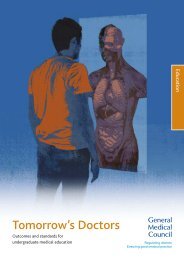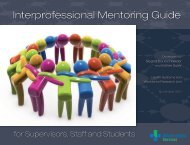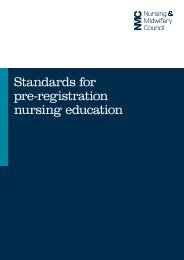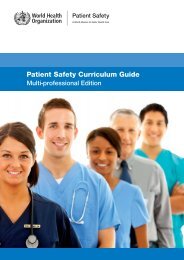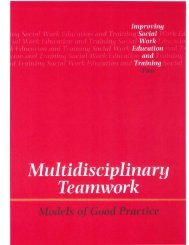Developing Interprofessional Education in health and social care ...
Developing Interprofessional Education in health and social care ...
Developing Interprofessional Education in health and social care ...
You also want an ePaper? Increase the reach of your titles
YUMPU automatically turns print PDFs into web optimized ePapers that Google loves.
Students were expected to achieve the learn<strong>in</strong>g outcomes through exposure tolearn<strong>in</strong>g experiences <strong>in</strong>volv<strong>in</strong>g their fellows from other professional groups <strong>and</strong>construct<strong>in</strong>g learn<strong>in</strong>g conditions to support collaboration <strong>and</strong> learn<strong>in</strong>g. This curricularprocess was underp<strong>in</strong>ned by a model of learn<strong>in</strong>g <strong>and</strong> teach<strong>in</strong>g known as FacilitatedCollaborative <strong>Interprofessional</strong> Learn<strong>in</strong>g (FCIL) which comb<strong>in</strong>ed three pedagogies:guided discovery learn<strong>in</strong>g, collaborative learn<strong>in</strong>g <strong>and</strong> <strong>in</strong>terprofessional learn<strong>in</strong>g(Humphris & McLeod Clark, 2007).Common learn<strong>in</strong>g <strong>and</strong> <strong>in</strong>teractive learn<strong>in</strong>g both had their merits: the former offer<strong>in</strong>geconomy of scale <strong>and</strong> shared underst<strong>and</strong><strong>in</strong>g of basic knowledge across curricula;the latter provid<strong>in</strong>g experiential opportunities for discussion about roles,responsibilities <strong>and</strong> patient <strong>care</strong>. Good team work<strong>in</strong>g for future practitionersdepends on all these elements.Learn<strong>in</strong>g methodsNumerous learn<strong>in</strong>g methods were <strong>in</strong>troduced <strong>in</strong>to IPE schemes, some face to face;others mediated by technology (see chapter 5). Interactive methods <strong>in</strong>cludeddiscussion, debates, problem-based <strong>and</strong> case-based learn<strong>in</strong>g <strong>and</strong> small group work.Common learn<strong>in</strong>g <strong>in</strong>cluded lectures <strong>and</strong> large group sem<strong>in</strong>ars. Placements providedopportunities to practice <strong>in</strong> <strong>in</strong>terprofessional student teams as well as service audit,shadow<strong>in</strong>g members of other professions, observ<strong>in</strong>g <strong>and</strong> participat<strong>in</strong>g <strong>in</strong> teammeet<strong>in</strong>gs <strong>and</strong> <strong>in</strong>terviews with service users <strong>and</strong> <strong>care</strong>rs. Opt<strong>in</strong>g for only one methodwould have been needlessly constra<strong>in</strong><strong>in</strong>g fail<strong>in</strong>g to respond to the range <strong>and</strong>diversity of students‟ needs <strong>and</strong> learn<strong>in</strong>g styles. Problem based learn<strong>in</strong>g (PBL)featured less <strong>in</strong> UK IPE than might have been expected given its commendation bythe WHO as the cornerstone for <strong>in</strong>terprofessional learn<strong>in</strong>g (WHO, 1988). TheUniversity of Salford was alone <strong>in</strong> modell<strong>in</strong>g its approach explicitly on the advicefrom WHO draw<strong>in</strong>g on pioneer<strong>in</strong>g work <strong>in</strong> Adelaide (Australia) <strong>and</strong> L<strong>in</strong>kop<strong>in</strong>g(Sweden) (Davidson & Lucas, 1995) although others, such as St George‟sUniversity of London <strong>and</strong> the University of the West of Engl<strong>and</strong>, also <strong>in</strong>troducedsimilar enquiry <strong>and</strong> problem based methods.The range of methods <strong>in</strong>troduced <strong>in</strong>to IPE exemplified the “new pedagogy” draw<strong>in</strong>gon constructivist theory (Cullen et al., 2002), grounded <strong>in</strong> expository, <strong>in</strong>teractive,conversational <strong>and</strong> experiential practice-based methods where the learners activelyconstruct knowledge for themselves from an array of experiences rather thanfocus<strong>in</strong>g on knowledge-based subject matter transferred from the teacher to thetaught (Bruner, 1966). The adoption of this constructivist epistemology <strong>and</strong> adultlearn<strong>in</strong>g pr<strong>in</strong>ciples led to a shift <strong>in</strong> <strong>in</strong>terprofessional teach<strong>in</strong>g <strong>and</strong> learn<strong>in</strong>g towardsmore experiential (Kolb, 1984) <strong>and</strong> more reflective (Schön 1987) styles wherelearn<strong>in</strong>g was “situated” with<strong>in</strong> “communities of practice” (Lave & Wenger, 1991;Wenger, 1998) <strong>in</strong>formed by role-modell<strong>in</strong>g theory where students identified withexamples of positive practice (B<strong>and</strong>ura, 1986). Students were adult learners(Knowles 1973, 1985) responsible not only for their own learn<strong>in</strong>g but also that ofothers as a collective <strong>and</strong> collaborative responsibility (Barr, 2002; Hammick et al.,2007; O<strong>and</strong>asan & Reeves, 2005).The application of constructivist theories to <strong>in</strong>terprofessional learn<strong>in</strong>g may havebeen more comfortable for students follow<strong>in</strong>g more humanistic professional courses,which allowed more room for difference <strong>and</strong> debate, than for those follow<strong>in</strong>g morescientific professional courses with more emphasis on h<strong>and</strong><strong>in</strong>g down evidencebasedknowledge. Nor was it clear for some students how such learn<strong>in</strong>g would21




